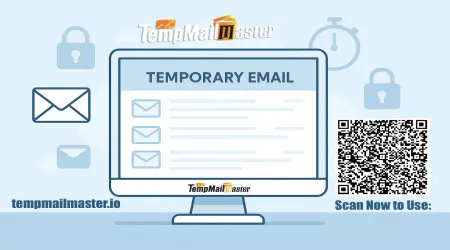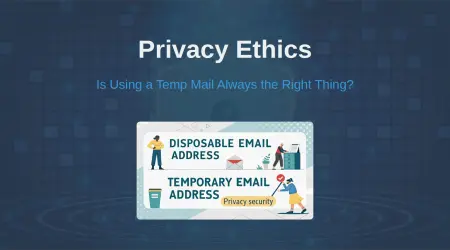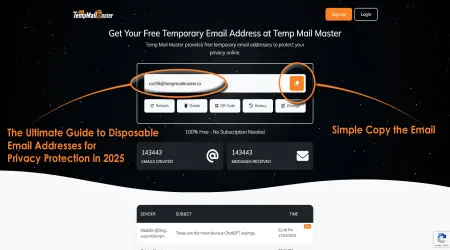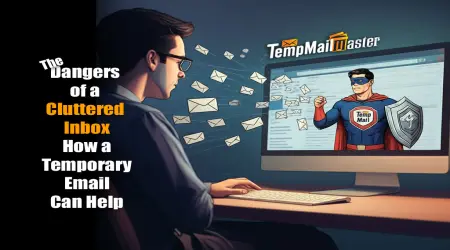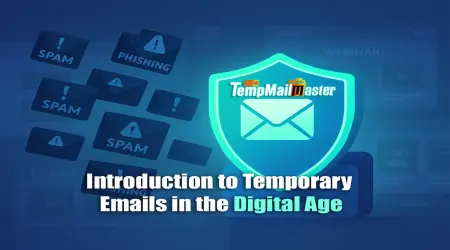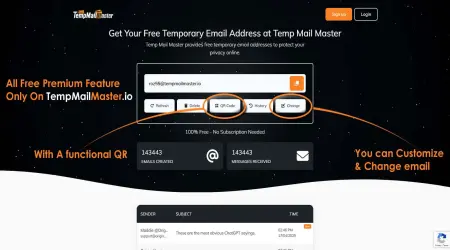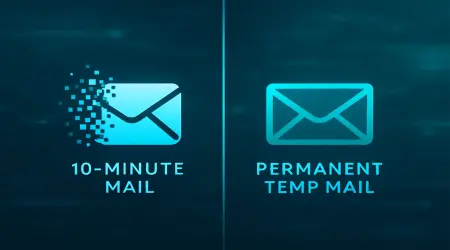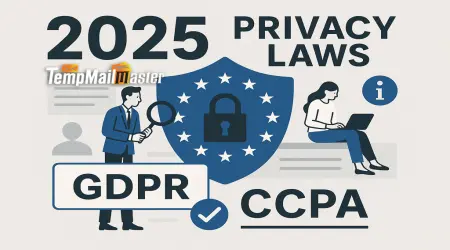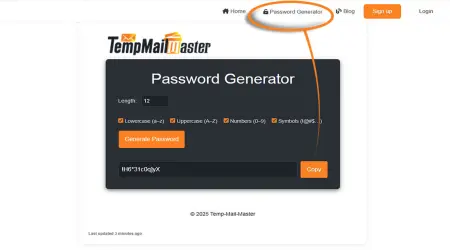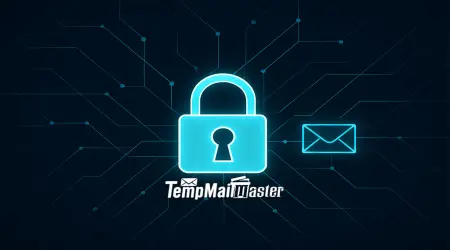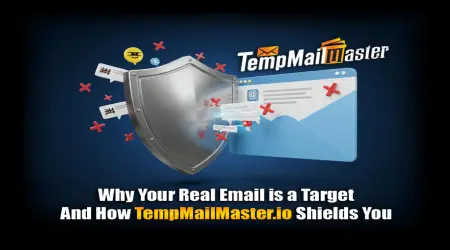

Build a Digital Moat: Master Email Privacy & Inbox Control
Ever feel like your primary email inbox is less a sanctuary and more a digital battleground? A place where spam, newsletters you vaguely remember signing up for, and phishing attempts wage a constant war for your attention? It’s not just you. In my opinion, the modern inbox has become a chaotic space, constantly demanding our time and energy, making it tough to focus on what truly matters. This constant barrage doesn\'t just distract; it erodes our sense of digital peace and leaves us vulnerable.
I recall a time when my inbox felt like a runaway train, overflowing with irrelevant messages. I was spending precious minutes each day sifting through junk, trying to find the few important emails buried beneath the digital clutter. It felt like I was always reacting, always playing defense, never truly in control. This daily struggle made me realize that a reactive approach to email simply doesn\'t cut it anymore; we need something more robust, something that puts us back in the driver\'s seat of our digital lives.
This article isn\'t just another guide to email etiquette; it’s a deep dive into building what I like to call a “digital moat”—a proactive system designed to safeguard your primary inbox. By the time you finish reading, you’ll understand how to construct an impenetrable barrier against unwanted digital intrusions, reclaim your focus, and establish a true digital privacy system. We’ll explore practical strategies and innovative tools that empower you to transform your inbox from a source of stress into a streamlined communication hub.
So, if you’re tired of the endless email onslaught and ready to take back control, keep reading. We’re about to embark on a journey to fortify your digital boundaries, ensuring that only the most relevant and important communications reach your primary inbox. It’s time to stop reacting and start building a proactive defense that serves your digital well-being.
Introduction to The Digital Moat: A Proactive System to Wall Off Your Primary Inbox
What is The Digital Moat: A Proactive System to Wall Off Your Primary Inbox? (Definition and Importance)
So, what exactly is this \'digital moat\' I keep talking about? Think of it like the old-school moats around castles, but for your email. It’s a strategic, proactive defense system designed to protect your primary inbox from the relentless onslaught of unwanted emails. We’re talking about everything from spam and phishing attempts to those annoying promotional emails you never asked for. The goal here is simple: to create a clear, impenetrable barrier that ensures only the communications you truly value make it through.
In my experience, the importance of this system can’t be overstated. It’s not just about reducing clutter; it’s about reclaiming your digital peace of mind. When your inbox is a constant source of distraction, it drains your energy and makes it harder to focus on what’s important. A digital moat acts as your personal digital privacy system, significantly cutting down on the noise and allowing you to engage with your email on your terms, not the internet’s. It’s about taking back control, one email at a time.
Brief History and Etymology of The Digital Moat: A Proactive System to Wall Off Your Primary Inbox
The term \'moat\' itself has a fascinating history, stemming from Old French \'mote,\' referring to a mound or embankment. Originally, these were defensive earthworks, later evolving into the water-filled ditches we commonly associate with medieval castles. The idea was simple: create a formidable barrier to deter unwanted intruders. I think this historical context perfectly illustrates the core concept we’re applying to our digital lives. We’re building a modern-day fortress for our inboxes, using the same principles of strategic defense.
The evolution of email security has been a bit of a wild ride, wouldn’t you agree? In the early days of the internet, email was a relatively open frontier. Spam was a nuisance, but not the overwhelming tide it is today. As our digital lives became more intertwined with our inboxes, so too did the sophistication of unwanted intrusions. From simple spam filters to complex algorithms designed to detect phishing, the tools have changed, but the fundamental need for a strong defense remains. The digital moat is, in essence, the culmination of this ongoing battle for inbox protection, offering a comprehensive and forward-thinking approach.
Understanding the Linguistic and Conceptual Aspects
Semantically Relevant Terms and Their Significance
When we talk about a digital moat, we’re touching on a whole ecosystem of related concepts. Terms like \'email security,\' \'inbox management,\' and \'digital privacy protection\' are all part of the same family. Think of \'spam prevention\' as a crucial component, or \'email organization\' as a direct benefit. We’re also dealing with \'privacy barriers\' and \'digital boundaries,\' which are fundamental to the entire idea. These aren’t just buzzwords; they’re the building blocks of a truly effective \'digital fortress\' for your inbox. Each term, from \'email segregation\' to \'inbox isolation,\' highlights a different facet of what it means to have a truly protected and manageable email experience. It’s about creating a \'privacy shield\' that keeps the bad stuff out and lets the good stuff in.
Lexical Terms & Common Usage
Let’s break down some of the key words that make up this concept. \'Moat,\' as we discussed, is that protective barrier. To \'wall off\' means to isolate or separate, which is exactly what we’re doing with your \'primary inbox\' – your main email account. The \'proactive\' part is crucial; it means we’re being preventive and anticipatory, not just reacting to problems after they happen. The \'system\' is the method or framework we’re putting in place. And of course, \'digital\' refers to everything electronic and online. When I say \'protection,\' I mean security and defense. A \'barrier\' is an obstacle or shield, and a \'filter\' is how we screen and sort. Finally, a \'gateway\' is the entry point, the access control for your email. These words, when combined, paint a clear picture of what we’re trying to achieve.
Polysemy & Multiple Meanings in Different Contexts
It’s interesting how some words have multiple meanings, isn’t it? Take \'moat,\' for example. It can be that water-filled ditch around a castle, but it’s also a powerful metaphor for a protective barrier, and even a term in business for a competitive advantage. Similarly, a \'wall\' can be a physical structure, a digital firewall, or even a metaphorical separation. A \'filter\' can be a physical device for straining, a digital algorithm for sorting, or even a mental process of screening information. A \'system\' can be an organized method, computer software, or even a biological organism. And \'primary\' can mean first in importance, your main email account, or something basic and fundamental. Understanding these different layers of meaning helps us appreciate the depth of the \'digital moat\' concept and how it applies to various aspects of our lives.
Exploring The Digital Moat: A Proactive System to Wall Off Your Primary Inbox in Depth
Hyponyms & Hypernyms – Where It Fits in a Broader Sense
To truly grasp the digital moat, it helps to see where it fits within the larger landscape of digital security. Think of \'cybersecurity\' as the vast ocean, and our digital moat is a powerful, specialized vessel sailing within it. \'Digital privacy\' and \'information security\' are also broader categories that encompass our efforts. More specific elements, or \'hyponyms,\' of a digital moat include things like \'temporary email addresses,\' which I’ve found incredibly useful for signing up for services without exposing my main inbox. \'Disposable email services\' and \'email aliases\' are also fantastic tools in this arsenal. We’re talking about \'spam filters,\' \'whitelist systems,\' and \'blacklist protocols\' – all working in concert. Even \'email encryption tools\' and \'two-factor authentication for email\' play a role in fortifying your defenses. These are the granular components that make the broader \'hypernyms\' like \'digital hygiene\' and \'privacy management\' truly effective. It’s all part of a comprehensive \'online safety\' strategy.
Holonyms & Meronyms – The Whole and Its Parts
Now, let’s consider the digital moat as both a part of something bigger and something made up of smaller pieces. As a \'holonym,\' the digital moat is a crucial element of a \'comprehensive privacy strategy\' or a \'personal cybersecurity plan.\' It’s a significant piece of your overall \'digital privacy toolkit\' and contributes to a robust \'online security infrastructure.\' It’s not just a standalone solution; it’s integrated into a broader \'privacy-first digital lifestyle.\' On the flip side, the digital moat itself is composed of various \'meronyms,\' or component parts. These include the \'email filters\' that do the heavy lifting, the \'temporary email generators\' that create those disposable addresses, and the \'alias creation tools\' that give you flexibility. We’re talking about \'spam detection algorithms,\' \'whitelist databases,\' and \'blacklist repositories\' working behind the scenes. Even things like \'notification controls\' and \'auto-delete functions\' are small but mighty parts of this larger system. It’s a symphony of tools and techniques, all playing their part in protecting your inbox.
Synonyms & Antonyms – Alternative Meanings and Opposites
Sometimes, understanding what something *isn\'t* helps clarify what it *is*. When we talk about a \'digital moat,\' we’re essentially building an \'email fortress\' or an \'inbox protection system.\' You could call it a \'digital email barrier\' or a \'privacy email shield.\' These \'synonyms\' like \'secure email gateway\' or \'email defense mechanism\' all point to the same core idea: creating a strong, protective layer around your primary inbox. On the other hand, the \'antonyms\' paint a picture of what we’re trying to avoid. An \'open inbox policy\' or \'unfiltered email access\' is the antithesis of a digital moat. We’re actively working against \'public email exposure\' and \'unrestricted email sharing.\' The goal is to prevent \'email vulnerability\' and \'inbox chaos,\' and to avoid \'email security negligence\' at all costs. It’s about closing those \'open digital doors\' and securing your \'unguarded inbox.\' By understanding both the synonyms and antonyms, we get a clearer picture of the purpose and impact of a digital moat.
Contextual and Semantic Associations
Collocations – Common Word Combinations with The Digital Moat: A Proactive System to Wall Off Your Primary Inbox
Certain words just naturally go together, don’t they? When we talk about a digital moat, you’ll often hear phrases like \'build a moat\' – because that’s exactly what you’re doing. We’re focused on \'digital protection\' and \'email privacy.\' \'Inbox security\' is a key outcome, and it’s all about a \'proactive defense.\' The \'system implementation\' is how we put it into practice. We’re establishing \'privacy barriers\' and putting \'security measures\' in place. Effective \'email management\' is a direct result, and it’s all about setting clear \'digital boundaries.\' These \'collocations\' like \'protection protocols,\' \'security framework,\' \'privacy strategy,\' \'defense mechanisms,\' and \'isolation techniques\' are the language of a well-fortified inbox. They help us communicate the essence of the digital moat concept effectively.
Connotations – How The Digital Moat: A Proactive System to Wall Off Your Primary Inbox is Perceived in Different Contexts
Words carry weight, and \'digital moat\' is no exception. The term immediately conjures feelings of \'security\' – safety, protection, and that wonderful peace of mind. It speaks to \'privacy\' – personal space, confidentiality, and control over your own data. The \'proactive\' aspect implies forward-thinking, preventive action, and smart planning, which I think is incredibly empowering. \'Digital\' grounds it in our modern, technological, and efficient world. And \'moat\' itself, with its historical ties to medieval castles, brings to mind an impenetrable defense and a strategic barrier. When we talk about a \'system,\' it suggests something organized, methodical, and reliable. Ultimately, the digital moat connotes a sense of \'empowerment\' – taking control of your digital life and protecting yourself. It’s about being professional and effective in how you manage your online presence.
Semantically Related Entities – Related Concepts and Connections
The digital moat doesn’t exist in a vacuum; it’s connected to a whole network of tools and concepts. Think about \'Gmail filters\' or \'Outlook rules\' – these are practical applications of the moat concept within popular email platforms. \'Apple Mail privacy features\' and \'ProtonMail security\' are examples of services that inherently offer aspects of a digital moat. Then there are the external tools: \'temporary email services\' like 10MinuteMail or Guerrilla Mail are fantastic for one-off sign-ups. \'Email clients\' like Thunderbird or Spark can offer more granular control. Beyond email, the principles extend to \'VPN services,\' \'password managers,\' and \'two-factor authentication apps\' – all part of a broader strategy for online safety. Even \'privacy-focused browsers,\' \'ad blockers,\' and \'anti-malware software\' contribute to the overall digital defense. It’s about building a layered approach, where each piece reinforces the others to create a truly secure digital environment.
Attributes and Characteristics of The Digital Moat: A Proactive System to Wall Off Your Primary Inbox
Common Attributes Found in The Digital Moat: A Proactive System to Wall Off Your Primary Inbox
What can you expect from a well-implemented digital moat? For starters, it \'reduces spam and unwanted emails\' significantly. It \'protects personal information\' from falling into the wrong hands, and it \'improves email organization,\' making your inbox a much more pleasant place to be. You’ll find it \'saves time on email management\' because you’re not constantly sifting through junk. Crucially, it \'enhances digital privacy\' and \'prevents data breaches,\' which are major concerns in today’s world. It also \'reduces phishing risks\' and \'improves productivity\' by cutting down on distractions. Ultimately, it \'provides peace of mind,\' which, in my opinion, is priceless. Most digital moat strategies are \'easy to implement,\' \'cost-effective solutions,\' and \'scalable approaches\' that can grow with your needs. They’re often \'user-friendly\' and \'compatible with major email providers,\' with \'customizable settings\' to fit your specific preferences. It’s a win-win.
Rare Attributes That Are Less Discussed
Beyond the obvious benefits, a digital moat offers some less-talked-about advantages. For instance, it \'prevents email pattern analysis by marketers,\' making it harder for companies to build detailed profiles based on your email habits. It \'reduces digital fingerprinting opportunities\' and \'minimizes cross-platform data correlation,\' which are subtle but powerful forms of privacy invasion. I’ve found it can even \'protect against advanced persistent threats (APTs)\' by limiting attack vectors. It \'prevents email-based social engineering reconnaissance,\' where bad actors gather information about you through your email. It \'reduces metadata exposure\' and \'limits behavioral profiling through email habits,\' giving you more control over your digital footprint. It can even \'protect against email timing analysis attacks\' and \'prevent email header information leakage,\' which are more sophisticated privacy concerns. And yes, it \'reduces risk of email-based identity correlation\' and \'minimizes exposure to zero-day email exploits.\' These are the deeper layers of protection that a truly robust digital moat provides.
Unique Attributes That Make The Digital Moat: A Proactive System to Wall Off Your Primary Inbox Stand Out
What truly sets the digital moat apart? I think it’s the powerful \'medieval castle-like defense metaphor\' that makes complex privacy concepts so relatable. It’s a system that \'combines ancient military strategy concepts with cutting-edge privacy technology,\' which is just cool, if you ask me. It fundamentally \'transforms email management from reactive to proactive approach,\' shifting your mindset from constantly putting out fires to building an unbreachable defense. It \'establishes a psychological barrier between personal and public digital identity,\' helping you maintain clear boundaries. It’s a \'systematic approach to email privacy that scales with digital lifestyle complexity,\' meaning it grows with you. Crucially, it \'adapts to evolving privacy threats without requiring technical expertise,\' making it accessible to everyone. The \'visual metaphor\' itself makes these complex privacy concepts accessible to non-technical users, which is a huge win. And finally, it \'integrates seamlessly with existing email workflows without disrupting productivity,\' so you don’t have to completely overhaul your digital life to implement it. It’s a smart, intuitive way to protect yourself.
Practical Applications and Use Cases
How The Digital Moat: A Proactive System to Wall Off Your Primary Inbox is Used in Different Industries
The beauty of the digital moat is its versatility. In the legal sector, where client confidentiality is paramount, a digital moat ensures sensitive communications remain private, shielding lawyers from unwanted solicitations and potential data breaches. For healthcare professionals, it’s about protecting patient data and maintaining HIPAA compliance, preventing the primary inbox from becoming a weak link in their security chain. Even in creative fields, where artists and designers often share portfolios and collaborate, a moat can prevent intellectual property theft and reduce the influx of irrelevant pitches. I’ve seen it used by small business owners to segment customer inquiries from spam, ensuring they don’t miss crucial sales leads. For educators, it helps manage student communications without being overwhelmed by administrative noise. The principles are universal: wherever there’s an inbox, there’s a need for a digital moat to ensure focused, secure, and efficient communication.
Misconceptions and Misinterpretations (Antonyms in Context)
It’s easy to misunderstand what a digital moat is, especially when we’re so used to the opposite. Some might think it’s an \'open inbox policy,\' where everything comes in, and you sort it later. But that’s precisely what we’re trying to avoid. It’s not about \'unfiltered email access\' or \'public email exposure\'; it’s about deliberate control. A digital moat is not a system that encourages \'unrestricted email sharing\' or leaves you open to \'email vulnerability.\' In my opinion, believing your inbox is inherently secure without proactive measures is a dangerous \'misinterpretation.\' We’re actively working against \'inbox chaos\' and \'unprotected communication.\' It’s not about \'email security negligence\' or leaving \'open digital doors.\' The digital moat is the antidote to an \'unguarded inbox\' and \'email privacy abandonment.\' It’s about being intentional, not passive, in your digital defense. It’s the opposite of digital exposure and communication vulnerability; it’s about building resilience.
Conclusion and Final Thoughts
Recap of Key Points
So, where does all this leave us? We’ve journeyed through the concept of the digital moat, understanding it not just as a fancy term, but as a vital, proactive system for safeguarding your primary inbox. We’ve seen how it leverages ancient defensive strategies for modern digital challenges, transforming your email experience from a chaotic free-for-all into a controlled, secure environment. From understanding its linguistic roots to exploring its myriad attributes, both common and rare, it’s clear that building a digital moat is about more than just blocking spam; it’s about reclaiming your digital autonomy and peace of mind. It’s about being intentional with your digital interactions, ensuring that your inbox serves you, not the other way around. I truly believe this approach is a game-changer for anyone feeling overwhelmed by their digital life.
Future Trends and Emerging Discussions Related to The Digital Moat: A Proactive System to Wall Off Your Primary Inbox
The digital landscape is always shifting, and so too will the evolution of the digital moat. I anticipate a future where AI-powered email assistants become even more sophisticated, not just in filtering, but in proactively identifying and neutralizing emerging threats before they even reach your inbox. We might see more widespread adoption of decentralized email systems, offering even greater privacy and control. The discussion around digital identity and data ownership will only intensify, making the principles of the digital moat even more relevant. As our lives become increasingly intertwined with digital communication, the need for robust, adaptable, and user-friendly systems to protect our primary inboxes will become paramount. The digital moat isn’t just a trend; it’s a foundational concept for a healthier, more secure digital future. It’s about staying one step ahead in an ever-evolving digital world.
Start building your moat with a free temp email.
Frequently Asked Questions About The Digital Moat
Curious about how to truly wall off your primary inbox? Here are some of the most common questions I get about building a digital moat, along with my take on them.
What exactly is a “Digital Moat” for my inbox?
A Digital Moat is a proactive system designed to protect your primary email inbox from unwanted intrusions like spam, phishing attempts, and irrelevant newsletters. Think of it as building a defensive barrier around your most important digital communication channel, ensuring that only desired messages reach you. It’s about taking control and creating a more peaceful, productive email experience.
Why do I need a Digital Moat if I already have a spam filter?
While spam filters are a good first line of defense, a Digital Moat goes much further. Spam filters are often reactive, catching known threats. A moat is proactive, preventing unwanted emails from ever reaching your primary inbox in the first place. It involves strategies like using temporary emails for sign-ups, creating aliases, and segmenting your communications, offering a much more comprehensive and personalized layer of protection than a generic filter.
Will building a Digital Moat make me miss important emails?
Quite the opposite! A well-constructed Digital Moat is designed to *reduce* the noise, making it easier for you to spot and respond to important emails. By diverting irrelevant messages, you create a clearer path for critical communications. It’s about precision, not exclusion. You’ll find yourself spending less time sifting through junk and more time engaging with what truly matters.
Is setting up a Digital Moat complicated or time-consuming?
It might seem daunting at first, but setting up a Digital Moat can be surprisingly straightforward, and the long-term benefits far outweigh the initial effort. Many tools and techniques are user-friendly, and you can implement them gradually. Start with simple steps like using email aliases or a temporary email service, and build from there. It’s an investment in your digital well-being that pays dividends in reduced stress and increased productivity.
Can a Digital Moat protect me from phishing and scams?
Absolutely. By reducing the sheer volume of emails reaching your primary inbox, a Digital Moat significantly lowers your exposure to phishing attempts and scams. When fewer suspicious emails make it through, you’re less likely to accidentally click on a malicious link. It’s a crucial layer of defense that complements other security measures, making you a much harder target for cybercriminals.
What’s the single most important step to start building my Digital Moat?
In my opinion, the most impactful first step is to start using temporary or alias email addresses for any non-essential sign-ups or online interactions. This immediately creates a barrier between your primary inbox and the vast ocean of potential spam and marketing emails. It’s a simple yet powerful way to begin diverting unwanted traffic and reclaiming control over your digital space. Give it a try; you’ll be amazed at the difference it makes!
Written by Arslan – a digital privacy advocate and tech writer/Author focused on helping users take control of their inbox and online security with simple, effective strategies.
